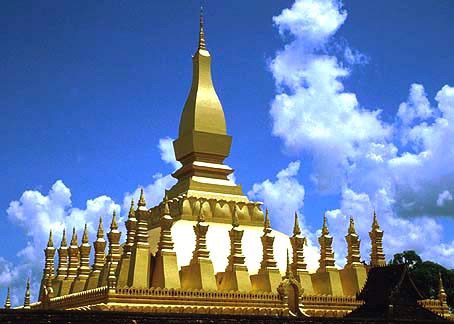Lao architecture is truly a national heritage which have been affected by Buddhism. The beautiful buildings we often see are Buddhist temples (wat), buildings and houses with these Buddhist designs in mind.
The That Luang in the capital Viengchun is a prime example of a wonderful Buddhist Stupa. One the other hand, we have the Wat Xieng Tong which represents the Xiengkhuang style. Similarly, we also have what has been come to be called the Vientiane and Luang Prabang styles. Contrasting, Vientiane and Luang Prabang styles, the former is a building indicative primarily of slender and tall attributes while the latter include much lower sweeping roofs that are a bit closer to the ground.
In most cases though, you will always find buildings that include several layers of high peaked roofs. Why is this? Again this attribute goes back to the Buddhist and Laotian beliefs. The numbers of layers in a roof was often in reference to a Buddhist doctrine, ie. the levels of existence or Enlightenment. Additionally it can be observed that the edges or tips of the roofs in a design shaped motif of a flame-like appearance. This connitates to the belief that these pointed edges were to ward off bad spirits away from the temples (or in other cases, buildings). In addition, most buildings (especially the wats and temples) have a gorgeous main front passage, decorated walls and roofs; many of which are adorned with Buddhist mythological stories or beings.
The Ancient Time
The earliest surviving man-made structures in Laos are the groups of standing stones and associated burial chambers at Hintang Houamuang in Houaphanh Province and Hintang Nalae in Luang Namtha Province (1000-500 BCE) and the clusters of stone jars at the Plain of Jars in Xieng Khouang Province (4th-2nd centuries BCE), all of which are believed to have functioned as prehistoric aristocratic necropolises.
The formation of petty kingdoms during the late prehistoric period necessitated the construction of large defensive fortresses, and as time went on their construction became more and more intricate, featuring substantial moated earthworks with wooden pallisades. With the development of larger kingdoms during the first millennium CE, elaborate royal palaces also began to make an appearance, but since these were constructed mainly from wood and other perishable materials, those not destroyed in countless wars would eventually have succumbed to the tropical climate. Early Hindu and Buddhist temples were initially established mainly in forest areas, often on the site of ancient animist shrines; many were located in caves or beneath rocky overhangs, while others were protected by thatched wooden canopies. Thereafter under royal patronage masonry steadily replaced wood and thatch as the principal construction material for religious buildings.
By the 3rd century CE the Mon had established a major city-state at Nakhon Pathom, west of Bangkok, from which they gradually built up a large mandala known as Dvaravati (6th-11th centuries), which stretched from southern Burma across what is now central Thailand. In 769 Dvaravati extended its power northwards to the present-day northern Thai city of Lamphun near Chiang Mai, where it founded the kingdom of Haripunjaya. The proliferation of ancient Buddhist sites marked by Dvaravati-style bai sema (temple boundary stones) found along the middle reaches of the Mekong River in what is now central Laos suggests that during this very same period the Mon also extended their sphere of influence eastwards from Haripunjaya through the modern Lao provinces of Bokeo, Sayaburi, Vientiane, Saysomboun, Borikhamxai and Khammouane. Mon city states established in this region included Souvannakhomkham in modern Bokeo Province, Candapuri (Chanthaburi, later the capital city of Vientiane) and neighbouring Sayfong in present-day Vientiane Prefecture, Phainam (later Viengkham) in modern Vientiane Province and Sri Gotapura (later Sikhottabong) in present-day Khammouane Province. Muang Sua (the original name for Luang Prabang) is also believed to have originated as a Mon settlement. The Mon played a crucial role in the propagation of Therevada Buddhism throughout the wider region, laying the groundwork for its subsequent consolidation as the state religion under the Fa Ngum dynasty of Lane Xang.
http://www.web-laos.com/




